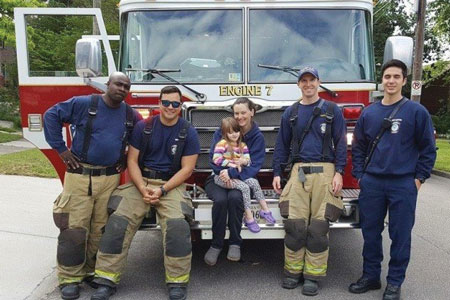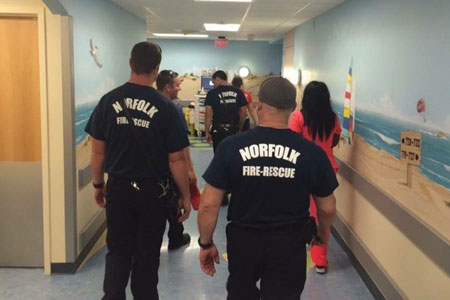
BY JARROD M. SERGI
Community risk reduction in our jurisdictions is one of the most essential activities in which a fire department will participate. Through risk reduction, we can target specific neighborhoods, identify threats, and come up with practical solutions. Community risk reduction can be defined or interpreted in many ways.
Consider a jar of your favorite spaghetti sauce. Imagine there was a problem with the glass jar constantly falling off the shelf and shattering all over the floor. How would we prevent this? We could move it to a lower shelf, switch from using a glass container to a plastic one, or place warning signs about the potential for a falling jar of Grandma’s best. We want to find a way to reduce or eliminate risk to our citizens. We have to find ways to keep that glass jar from breaking.
Company Officers
As a company officer, you set the tone for so much in your firehouse. You contribute to the cultural norms, attitudes, and other acceptable practices. As someone once told me, if it’s not important to you, it won’t be important to them. So where do we and where do you fit in the responsibility of reducing community risk?
First, you have to create buy-in. You have to change the mindset out in your stations. Many community risk programs in our fire departments come from our fire prevention bureaus. For some – probably most – fire departments, our prevention bureaus are stretched thin and overworked. Often (and I have been guilty of this), we in operations see these programs as the sole responsibility of the life safety educator or other fire prevention staff. Sometimes, operations, administration, training, and prevention exist like silos – that is, they all operate separately and stay isolated from one another with little information sharing or communication.
Firefighters
My department has 500 uniformed personnel serving a population of roughly 265,000 people and one life safety educator in our fire prevention bureau. That is a lot to put on one person, especially if the job is done correctly. We need to see it instead as having 500 life safety educators out there. We have many more than we realize – we just need to take a proactive approach and share the responsibility. As the company officer, you must constantly communicate to your members how important it is to take an active role in the community. Stress just how important it is to take part in events in your district that keep your fire department in the public eye (photo 1).
 |
| (1) Norfolk (VA) Fire-Rescue firefighters stop to talk with a little girl and her mother as they return from a call. (Photos by author.) |
We all swore an oath to protect life and property. I hear all the time, and I firmly believe, that the citizen is the number-one priority on the fireground. But is this the only time we like to say this? Is when we roll out the door for fires the only time we are using the words “citizens first”? Someone asked me this one day, and it got me thinking. They must be our priority off the fireground, too. Regardless of what programs your department has or doesn’t have, you have the ability to set the tone at the company level, and then maybe that tone will spread through your battalion, your shift, and then your whole department. Focus on the things that are within your control. As I stated before, we have one life safety educator, so the company officers and firefighters need to help lighten the load by initiating events on their own.
Children
Do you have schools in your district? Take a trip to the principal’s office, for good reason this time, and ask to come read to the kids and talk about fire safety. Sit down and have lunch with different age groups and discuss ways they can keep their family safe in a fire. Visit the local hospital and talk with burn patients. My crew and I visited a children’s hospital to spend some time with all of the kids. We wanted to give them the chance to take their minds off their illness, even if just for a few minutes. When those kids came down to see all the fire trucks and talk with the firefighters, their faces lit up like it was Christmas morning (photos 2-3).
 |
| (2) Firefighter Brendan Lorson assists a small child with a little nozzle work on a visit to the local hospital. |
We had such a good time interacting with the kids. It felt good to know that we helped them that day. They were fighting the challenge of flowing lines and picking up rescue tools while some of us were fighting back tears. To see the positivity and joy overflow from these children when they were dealing with some very severe illnesses was nothing short of inspiring. If you want to remind your crews of why they put on that uniform every day, set something like this up. It will surely make an impact on them and, most importantly, the children or whomever you reach out to.
Seniors
Are you constantly visiting your elderly citizens’ housing complexes or other senior living facilities? Do you know anyone in your community who is repeatedly having falls, cooking fires, and other incidents? Develop a slide presentation or use a ready-made one and request to visit these places. Don’t just go to the above-mentioned facilities either; civic league and community watch meetings are other good venues for spreading a message. All it may take is a short 30-minute class and some conversation to help them out. Teach the public to inspect their living spaces for loose rugs, handrails, or other faulty equipment that may be causing them to fall. Something as simple as moving the location of the telephone has helped.
The Public
At your next grocery store visit, keep someone at the truck. Open up all the compartment doors and pull a few pieces of equipment off the truck. When visitors approach, talk with them about what we do and how we may search their homes at a fire. Ask them if they have an escape route planned. Ask if they have working smoke detectors; if not, tell them how to get them. Such gestures will only continue to fill that reservoir of public trust. The public will know that its fire department is taking a genuine interest in its welfare and education.
 |
| (3) Norfolk firefighters visit some bedridden and critically ill patients and share a conversation about the fire department and what we do for them and the other citizens we are privileged to serve. |
Smoke Detectors
I realize not all departments have funding to buy smoke detectors or may not have a program in place at all. But if you do and your department is purchasing them for the citizens, use them! If you are on a medical run and you hear that “low-battery” chirp, ask the residents if they have a replacement battery. Are there other detectors in the home that may need new batteries or may need to be replaced? Maybe the home doesn’t have any at all. Instead of going right back in service, take an extra five minutes to install a detector in that home. That little bit of extra time could potentially save someone’s life.
The purpose of all this is one word: “ownership.” Take ownership of your responsibility as a life safety educator; that’s what you are. It is the firefighter’s responsibility. Take ownership of the programs you can control, and even start. Don’t kick everything down the road to the fire prevention bureau. Moreover, don’t wait for fire prevention to come to you. Set a tone in your stations that involvement in the community builds trust, keeps citizens safe, and ultimately builds a good relationship between the fire department and the citizens you serve.
We have to take an active role as educators, advocates, and champions of the districts in which we respond. Remember, if it’s not important to you, it won’t be important to them. Ask your crew about programs they may want to see happen or ways that they can get involved. Include them in the decision-making process, and you will begin to change the mindset. Approach community risk reduction with a positive attitude and take ownership today.
JARROD M. SERGI is a lieutenant with Norfolk (VA) Fire-Rescue, assigned to a ladder company in the First Battalion. He instructs in local and regional training programs with the Virginia Department of Fire Programs (focusing on strategy and tactics and Mayday operations) and with Real Fire Training, LLC. He has a bachelor’s degree in fire science and is the founder of Trial by Fire.
Creating Positive Public Relations
CREATING A DYNAMIC PUBLIC EDUCATION PROGRAM
Stay Current on Fire Safety Education
Fire Engineering Archives

